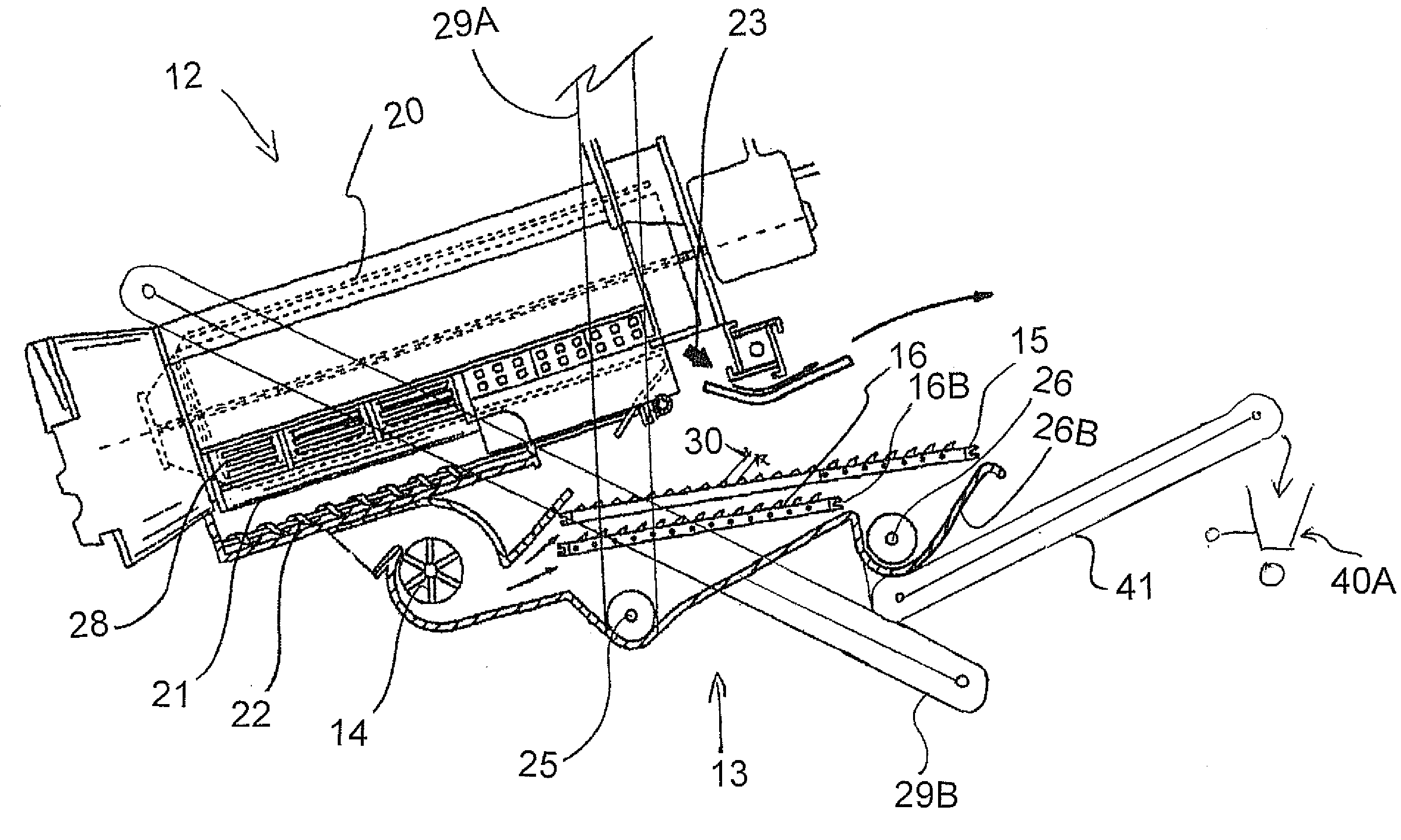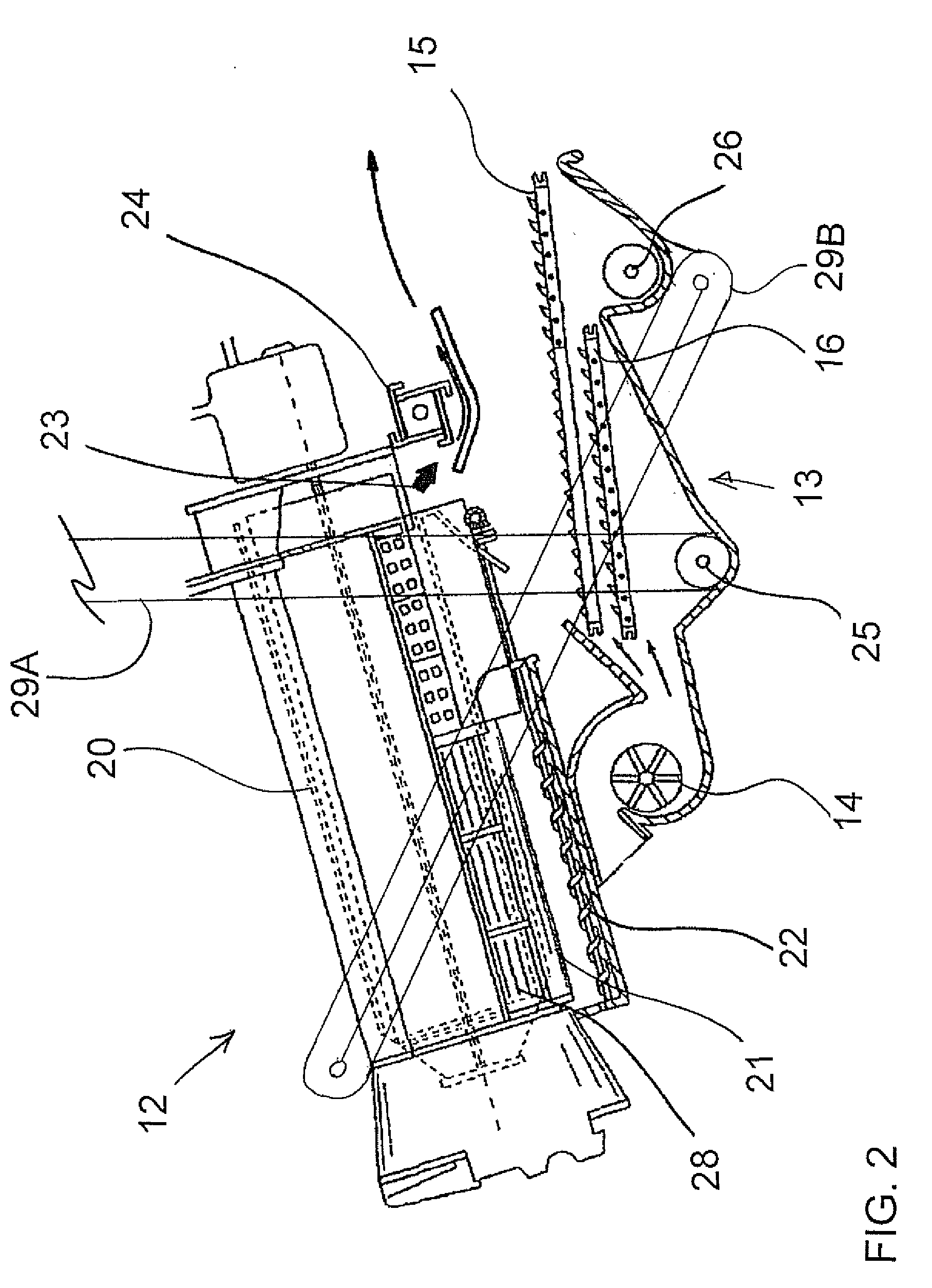Separating cobs from grain in a corn harvester
a corn harvester and cob technology, applied in the field of separation of cobs from grain in corn harvesters, can solve the problems of increasing field traffic, increasing operator stress, and crude current methods of collecting whole cobs, so as to reduce trips, reduce compaction, and eliminate the need for field side separation
- Summary
- Abstract
- Description
- Claims
- Application Information
AI Technical Summary
Benefits of technology
Problems solved by technology
Method used
Image
Examples
first embodiment
[0056]Referring to the present invention as shown in FIG. 4, the combine threshing system 12 is set-up as in FIG. 3 using the CCM system to separate the corn from the cob and to break the cob into segments.
[0057]The material containing the corn and cobs falls through the concaves 21 to the augers 22 and is conveyed to the upper sieve 15 as in FIG. 3. The upper sieve 15 has the openings 30 set large enough to allow passage of the corn and cobs through the sieve with the remaining chaff exiting the rear of the sieve as before.
[0058]The lower sieve 16 remains installed and screens the grain from the cob segments. All clean grain is moved to the elevator 29A by the cross auger 25. All cob segments and any other material that did not fall through lower sieve 16 exits the rear end 16B of the lower sieve and falls into the tailings trough 26B of the tailings cross auger 26.
[0059]The tailings elevator 29B does not receive the material from the transverse auger 29. An additional conveyor 41 ...
second embodiment
[0060]Referring to FIG. 51 the present harvester is shown. Like the harvester shown in FIG. 4 the combine is set-up to separate the corn from the cob and to break the cob into segments. The cob and corn material falls through the concaves 21 to the augers 22 to be carried to the cleaning system 13.
[0061]Like the harvester in FIG. 4, the lower sieve 16 remains installed and screens the grain from the cob segments. All clean grain is moved to the elevator 29A by the cross auger 25. All cob segments and any other material that did not fall through lower sieve 16 exits the rear end 16B of the lower sieve and falls into the trough 26B as before. The auger 26 moves the cob segments into a secondary separator 40, which removes any remaining grain from the cob sections. The grain passes through the separator and is dropped into the elevator 29B where it is returned to the threshing system 20 for further processing. The cob segments enter the conveyor 41 and are moved to a second storage tan...
third embodiment
[0062]Referring to FIG. 6, the harvester of the present invention is shown. Like the embodiments shown in FIGS. 4 and 5 the combine is set-up to separate the corn from the cob and to break the cob into segments. The cob and corn material falls through the concaves 21 to the transport mechanism 22 to the cleaning system 13. The conventional sieves 15 and 16 remain in place. An additional corn cob sieve 50 is mounted above the upper sieve 15 with openings 51 set large enough to allow passage of the corn and cob material through the sieve with the remaining chaff exiting the rear of the sieve 50.
[0063]The standard upper sieve 15 and the lower sieve 16 below the additional sieve 50 receive the corn and cob material and are set as typical for harvesting corn grain. The auger 25 for the clean grain gathers the grain and moves it out one side of the machine to the clean grain elevator 29A, which deposits the grain in the grain tank 17. A tailings auger 26 returns any grain or chaff or smal...
PUM
 Login to View More
Login to View More Abstract
Description
Claims
Application Information
 Login to View More
Login to View More - R&D
- Intellectual Property
- Life Sciences
- Materials
- Tech Scout
- Unparalleled Data Quality
- Higher Quality Content
- 60% Fewer Hallucinations
Browse by: Latest US Patents, China's latest patents, Technical Efficacy Thesaurus, Application Domain, Technology Topic, Popular Technical Reports.
© 2025 PatSnap. All rights reserved.Legal|Privacy policy|Modern Slavery Act Transparency Statement|Sitemap|About US| Contact US: help@patsnap.com



